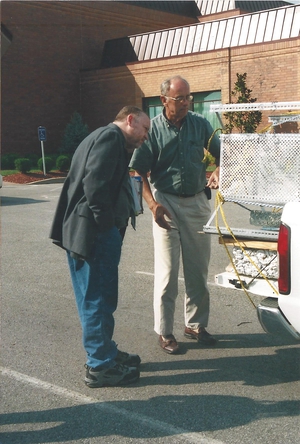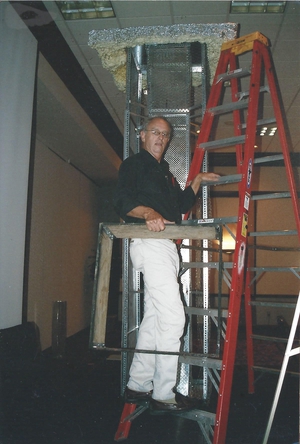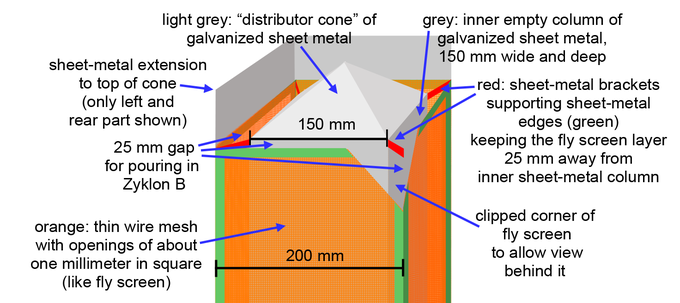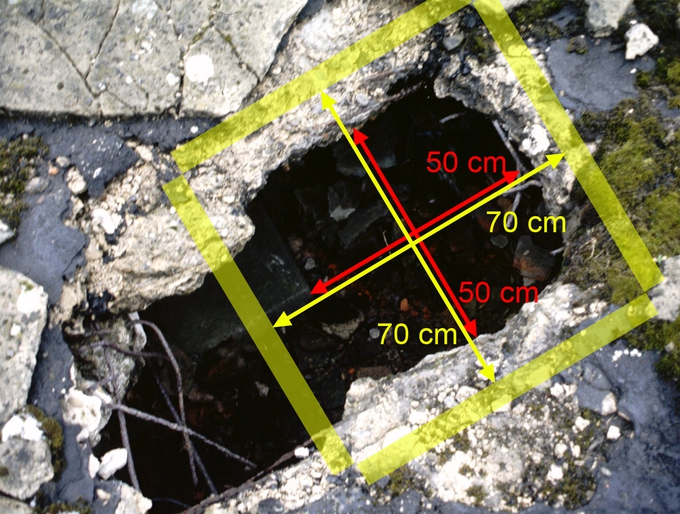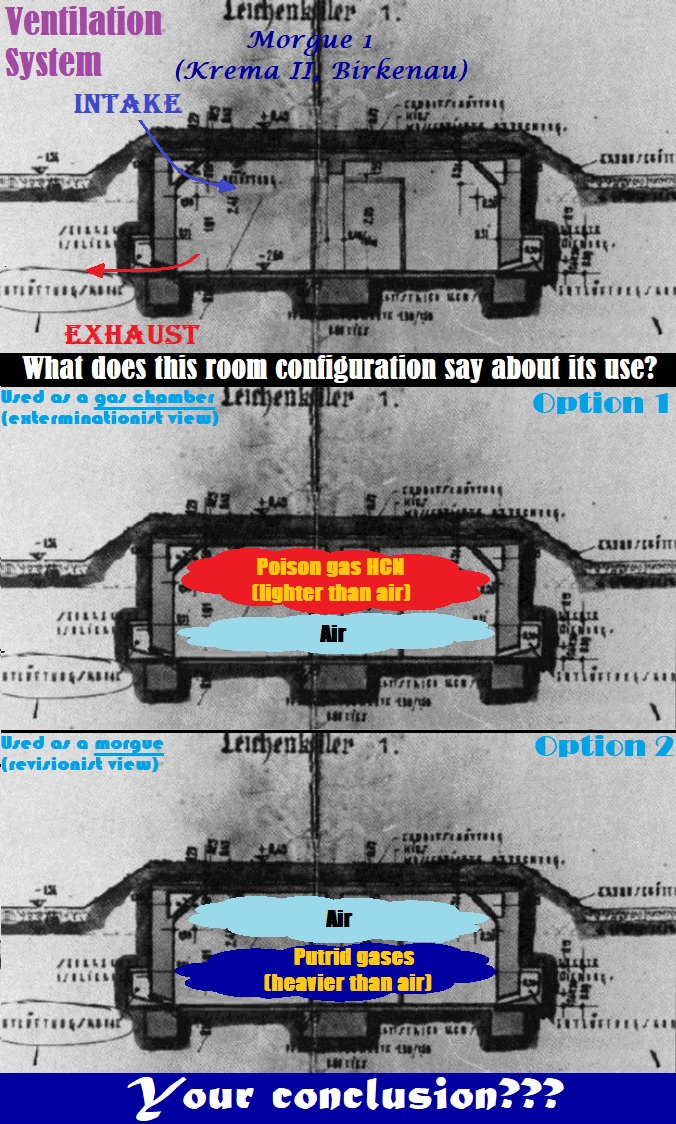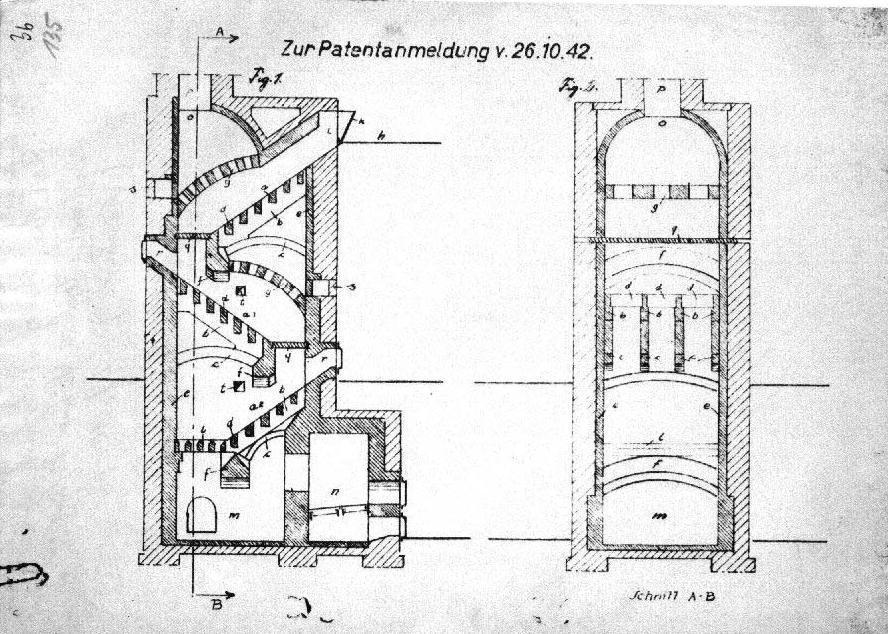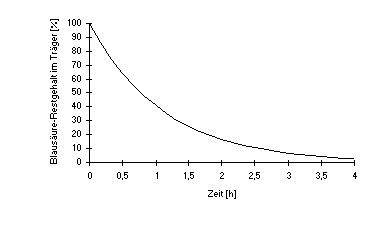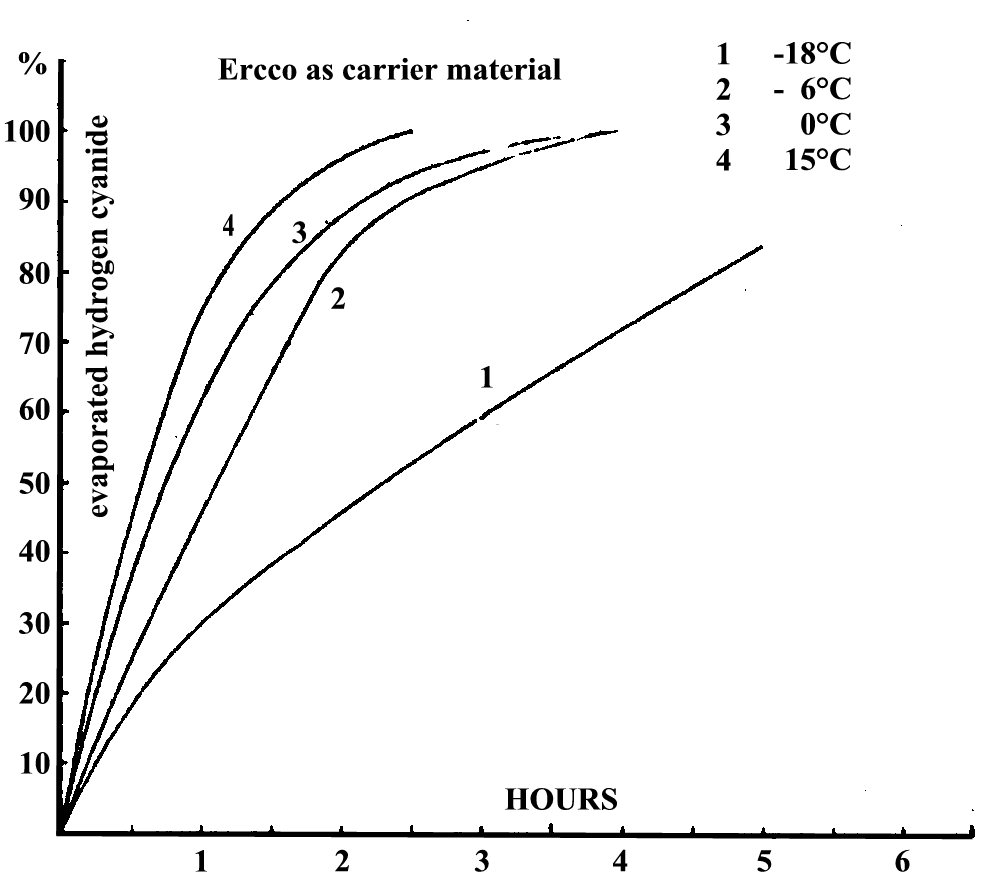Briefly, for the uninitiated:
- The pesticide Zyklon-B, the alleged killing agent in granular form supposedly used in 'Nazi homicidal gas chambers on an industrial scale at Auschwitz', was allegedly dropped into the alleged gas chambers.
- This was allegedly done by an SS man on the roof who supposedly dumped the Zyklon-B granules into openings / little chimneys / holes in the alleged gas chambers roof and into what are now called 'Kula columns', supposedly metal mesh containers hanging down into the claimed 'gas chambers'. So named after Polish Auschwitz 'inmate' Michał Kula.
- From there the Zyklon-B supposedly released it's cyanide load onto unsuspecting Jews, gays, &'others' who were allegedly deceived into thinking they were about to get showers.
Along with taking down Michał Kula himself, we have an utter demolition of his alleged 'Kula columns', better referred to as laughable Rube Goldberg contraptions.
While crucial to the impossible 'holocaust' narrative, these alleged columns are clearly shown to have been
Read on, comments invited.technically nonsensical.
- Hannover
The 'holocaust' storyline is one of the most easily debunked narratives ever contrived. That is why those who question it are arrested and persecuted.
http://codoh.com/library/document/4215/
from: Inconvenient History, Vol. 9 (2017), No. 1
Kula’s Columns Revisited
By Germar Rudolf
-----
This is a slightly adapted extract of the upcoming book The Chemistry of Auschwitz: The Technology and Toxicology of Zyklon B and the Gas Chambers – A Crime-Scene Investigation by Germar Rudolf (all color print, 442 pp. 6"×9"). The book is to be released in early March 2017.
Abstract
Since 2000 at the latest, the former Polish Auschwitz inmate Michał Kula has been quoted by mainstream Holocaust historians as the key witness describing how exactly Zyklon B was introduced in the homicidal gas chambers claimed to have existed in Crematoria II and III located in the Auschwitz-Birkenau Camp. This paper analyzes several of Kula’s postwar statements in this regard in order to accurately recreate what Kula described, to assess whether his claims are even technically feasible, and whether Kula’s statements about other aspects are historically accurate. It is demonstrated that Kula’s claims are untrue in many regards, that he has changed his story repeatedly, and that his claims are technically nonsensical.
-----
In 2002, during David Irving's “Real History” Conference in Cincinnati, the late Dr. Robert Countess presented a physical representation of “Kula’s Kolumns,” as he called them.[1] Since the year 2000, these columns have been at the center of a controversy about how exactly the insecticide Zyklon B is supposed to have been introduced into the Morgues #1 of Crematoria II and III at Auschwitz, where, the orthodox Auschwitz narrative has it, up to 400,000 human beings are said to have been poisoned to death. These morgues are sometimes referred to as “the absolute center of human suffering,” so when preparing the upcoming new edition of my expert report, I considered it important to shed some more light onto these devices.
llustration 1: Dr. Countess unloads his “Kula Kolumn” at the Cincinnati conference building in summer of 2002, with Charles Provan inspecting it.
The Auschwitz orthodoxy claims that four holes had been chiseled through the roof of the morgues in question. While some witnesses have claimed that the Zyklon B was simply dumped through those holes, others have claimed that some more-or-less-sophisticated devices were installed beneath those holes.
The most-prominent proponent of this hypothesis is Dutch historian of architecture Dr. Robert van Pelt, who in his book about Auschwitz published several construction drawings of these devices he himself had prepared.[2] Inspired by this, Dr. Countess built a model which he presented at the above-mentioned conference, see Illustrations 1f.
Illustration 2: Dr. Countess sets up his “Kula Kolumn” in the conference room in Cincinnati, summer 2002.
The issue was rekindled last year when a life-size model of the “Kula Kolumn,” built following van Pelt’s drawings, was exhibited at the Venice Biennale, an international exhibition on architecture. It featured prominently in an article in the New York Times about that exhibition,[3] including a photo of the device, see Illustration 3.
llustration 3: A Kula column freely interpreted by Robert van Pelt, exhibited at the Venice Architecture Biennale in 2016 (photo by Gianni Cipriano).
Van Pelt wasn’t the first to prepare construction drawings of these columns. That honor goes to the late French historian Jean-Claude Pressac, who had published his own drawings in his 1989 opus magnum.[4] Both authors have based their drawings on a postwar testimony by Michał Kula – hence the name of the columns. Kula was a Polish Auschwitz inmate who testified shortlyafter the war a number of times about what he claimed to have experienced at Auschwitz.
In addition to Kula’s statements, there are, to my knowledge, seven other witnesses claiming such columns: M. Nyiszli, C.S. Bendel, F. Müller and J. Erber, as well as W. Lutecki, W. Girsa and K. Gracz.[5] Müller’s and Erber’s descriptions stem from the late 1970s/early 1980s, while Bendel’s, Nyiszli’s, Lutecki’s and Girsa’s descriptions are very superficial. Gracz’s description is a little more-detailed and resembles Kula’s first description. Kula, however, is the one witness who described the columns early and in great detail, so I will focus on him here.
As far as I know, Kula testified at least three times after the war, first during the pre-trial investigations leading up to the show trial against former Auschwitz commandant Rudolf Höss, then during the trial itself, and finally during the trial against the Auschwitz camp garrison. Pressac and van Pelt merely considered Kula’s first testimony. However, in order to assess the accuracy of his testimony and his trustworthiness as a truthful witness, all of his testimonies need to be considered.
During his first deposition, Kula gave a very detailed description of these columns, so detailed, in fact, that he must have been involved in the columns’ manufacture, if they existed in the first place. Here is Kula’s statement from his deposition made prior to the trial against the former Auschwitz commandant Rudolf Höss:[6]
“Among other things, the fake showers intended for the gas chambers and the wire-mesh columns to pour the contents of the Zyklon cans into the gas chambers were manufactured in the metal workshop. This column was about 3 meters high, with a square section of about 70 cm [wide]. This column was composed of three mesh works inserted one inside the other. The outer screen was made from wire three millimeters thick, fastened to angle irons of 50 by 10 millimeters. Such corner posts were on each corner of the column and were connected at the top and the bottom by an angle iron of the same type. The openings of the wire mesh were 45 millimeters in square. The second screen was made in the same manner, and constructed within the first column [screen] at a distance of 150 millimeters from the first. The openings of this wire mesh were some 25 millimeters in square. In the corners these screens were connected to each other by iron struts. The third part of this column could be moved. It was an empty column of thin galvanized sheet metal with a square cross-section of about 150 mm, which ended in the upper part with a cone and below with a flat square base. At a distance of some 25 millimeters, thin sheet metal corners were welded to the corners of this column supported by sheet-metal brackets. On these corners was mounted a thin mesh with openings of about one millimeter in square. This mesh ended at the bottom of the cone, and from there, extending the meshwork, ran a sheet-metal casing for the entire height up to the top of the cone. The content of a Zyklon can was poured from above in the distributor cone, which allowed for an equal distribution of the Zyklon to all four sides of the column. After the evaporation of the gas, the entire central column was extracted and the evaporated [depleted] silica [carrier] removed.”
It doesn’t cast a favorable light on Kula’s credibility that the showers were actually real, as Mattogno has demonstrated abundantly.[7]
Kula was working in the inmate metalworking shop at Auschwitz, about whose activities a vast number of documents survived the war. No document about the creation of columns as described by Kula is among them, though. In fact, there is neither any material nor documentary evidence that these columns ever existed.[8] Kula himself must have anticipated this objection, because in the same testimony he claimed that work done for the crematoria were not registered presumably due to their alleged secret, criminal auspices. This, too, is untrue, as there is an abundance of work orders for items needed for the crematoria.[9]
Now to Kula’s next testimony. During the Höss Trial itself, he testified on the 5th day of that trial, where he stated the following:[10]
“On Höss’s order, the gassing columns that were used for the gassing were made by the metalworking shop. The columns were 2 meters and a half high, the inner space 150 square mm in diameter, the following [layer[11]] at a distance of 30 mm, the third 15 mm away. The wire mesh used was like those used for windows, green in color; between the mire mesh and the sheet metal there was a distance of 15 mm. All this was about 1 meter and a half tall. At the mouth of this network was a so-called distribution cone. 7 pieces of these columns were made. The columns were installed in the gas chamber right next to the opening through which the can of gas was thrown in. This column was installed beneath this opening, the gas was poured directly onto the distribution cone. The cone was to uniformly distribute the gas into these four slots of 15 mm between the sheet metal and the netting, since that increased the gas-evaporation surface. That way the victims could be killed more rapidly. [Question:] What did such a gas chamber look like? In one crematorium, it was calculated for 2,500 men, in the other, smaller one [gas chamber] in the same crematorium for 1,500. The workers of the metalworking shop, inmates, had built this chamber. The chamber was higher than 2 meters, at the top were closed rectangular channels; these were the air-extraction openings through which fans expelled the gas. Zyklon is lighter than air; hence it dissipates quickly after the gassing. Makeshift [fake] showers were made so that the whole thing looked like a bath. Lamps were lit, the concrete floor was always wet. After a homicidal gassing, inmates of the Sonderkommando cleaned the concrete [floor]. These were Jewish inmates who were assigned to doing that work. Every three months, the Sonderkommando was exterminated, gassed, yet not at Auschwitz, but somewhere in the vicinity of Gleiwitz instead. The leader of this unit was Hauptscharführer Moll, […]”
This passage is riddled with untrue statements.
1. As just mentioned, the showers and thus the bathing facilities were real.
2. The claimed capacity of 2,500 men for the alleged homicidal gas chamber, which has a surface area of some 200 m², is physically impossible (see Paragraph 7.3.2.1.1. in my expert report for details).
3. There were not two gas chambers of different sizes in that crematorium, but allegedly only one (Morgue #1).
4. The inmates of the metalworking shop had nothing to do with the construction of the crematoria, of which the gas chambers are said to have been integral parts. These inmates merely provided numerous iron fittings.
5. Even according to the orthodox narrative, nobody was ever gassed “in the vicinity of Gleiwitz.”
llustration 4: Author’s drawing of the “Zyklon-B-introduction columns” as described by Michał Kula in his pre-trial deposition. Black: 5-cm-wide corner irons of the outer column, 70 cm wide; red: 3-mm-thick wire mesh with mesh size 4.5 cm; green: outer column connected by struts (green; number of sets my guess) at the corners to the middle column (blue), made of the same corner irons, 15 cm away from the outer screen (column width: 40 cm); wire mesh with mesh size 2.5 cm (light green); orange: inner column, 20 cm wide, with fine wire mesh of mesh size 0.1 cm, 2.5 cm away from the inner sheet-metal column of 15 cm width (ochre). At the top end of the screen is the sheet metal extension covering the distributor cone (light grey). See the next Illustration for a close-up view of the top part of the inner column.
Since Kula was not a member of the Sonderkommando, one wonders what the source of his “knowledge” about the gas chambers and their operation is anyway. It probably is mere hearsay or rumor “knowledge,” which indicates that Kula’s testimony has been “cross-pollinated” by other witnesses.
Most important is, however, that he completely changed the dimensions of the Zyklon-B-introduction columns. That should be the first-hand, reliable and thus immutable aspect of his testimony. According to his first, pre-trial deposition, the column was 3 meters high, which he changed to 2.50 meters during the trial. While the inner core measures 150 mm wide in both testimonies, the column described in his testimony during the trial was only (15+30+150+30+15=) 240 mm wide in total, compared to the 700 mm of his pre-trial statement. These are obviously two entirely different objects he is describing. While one can confuse 3 m with 2.5 m, confusing 70 cm with 24 cm is not likely. Hence Kula has adjusted his statement. I’ll get to the probable reason for this later.
Illustration 5: Schematic drawing of the top part of the innermost column of the introduction device initially described by Kula. The width of the sheet-metal corners (green) and the height of the “distributor cone” and hence also of the sheet-metal extensions reaching to the height of the cone’s top are my assumptions.
To fully assess the reliability of Kula as a witness, it is worthwhile to also consider his last testimony known to me, which he gave during the trial against the Auschwitz camp garrison a few months after the Höss Trial. During that testimony, he did not mention the columns at all. But among other things, he stated the following:[12]
“Then they began to build gigantic crematoria. They were set up so that the victims could not understand where they were taken. Each crematorium had two gas chambers, one for 1,500 and one for 2,000 people. There was a special concrete ski-jump [skocznie, meaning chute] on which the people were thrown from the truck, [whose loadbed] tipped automatically, and in this way the people were falling into the gas chambers.”
This is a unique testimony, indeed. Although I do have words to characterize it, I will refrain from using them here. Evidently, with each opportunity to tell his tales, Kula’s claims became increasingly erratic.
Since his first description of the introduction column is more-detailed and was made earlier, orthodox scholars have relied on it. As mentioned before, both Pressac and van Pelt have prepared drawings of these columns based on Kula’s initial description. Neither of them is without flaws. For instance, Pressac got the dimensions of the inner column wrong and changed its design, while van Pelt’s translation of Kula’s testimony is erroneous, and though the data supplied in Kula’s testimony is rather meager, van Pelt uses it to make five different, very-detailed drawings – some of it necessarily based on his own conjecture. In order to get a more-realistic depiction of what Kula described in his first testimony, I created my own drawings, see Illustrations 4f. I have added only those features in them that Kula specifically mentioned. For instance, Kula did not say anything about any cross-bracing of the column, which would have been indispensable to make the device sturdy enough to withstand a panicking crowd.
Van Pelt recognized this deficiency; hence the model created based upon his drawing as exhibited during the 2016 Venice Biennale (see Illustration 3) shows tacit “corrections” to Kula’s claims: van Pelt’s column has cross braces dividing the column into three sections of roughly equal height. To reinforce the device further, van Pelt’s model also has much thicker wires on the outer layer – some 8 mm rather than the meager 3 mm claimed by Kula. In addition, van Pelt has reduced the width of the center column from the 40 cm claimed by Kula to some 30 cm. In fact, he should have reduced it even further than that, for the innermost, removable column with a claimed width of 20 cm needed a guide so it would not get accidentally stuck with one of its corners in the wire mesh of the middle column when accidentally lowered slightly tilted. The angle irons forming the corners of the middle column actually could have had no other purpose than to function as guide rails for the inner column when moving in and out. The middle column’s wire mesh was utterly superfluous and a waste. However, Kula claimed that the middle column was 40 cm wide, while the innermost was 20 cm wide. Hence it was a total mismatch. The situation is different for Kula’s second description, which has an equal clearance between each layer of just 15 mm.
Van Pelt also reduced the height of the outer column to considerably less than 3 meters as initially claimed by Kula. The reason for that is probably because there are no holes in the roof of the morgue in question measuring 70 cm × 70 cm into which Kula’s columns could have fit. The largest hole in that roof was only 50 cm wide in 1991, to which I will get further below. Hence van Pelt simply let the outer layer of his column end at the morgue’s ceiling and let only the smaller middle column protrude through the roof. This lack of holes of the required size proves categorically that Kula’s initially described columns cannot have been installed. That may also be the reason why Kula reduced the height down to 2.50 m in his testimony during the trial (although the ceiling in that room was only 2.40 m high).
Illustration 6 illustrates the issues involved. The green rectangle depicts Kula’s column, first design, with a huge, gaping hole needed to install it. The red, tilted rectangle shows a column of 2.40 m in height and 70 cm wide, as posited by van Pelt. Since it would have been impossible to carry it in one piece into that room and install it, it would have been necessary to assemble it from its components right on the spot. The yellow rectangle depicts Kula’s middle column, 40 cm wide, which could have been inserted through a hole of that size.
Illustration 6: Cross section through Morgue #1 of Crematories II and III (Pressac 1989, p. 329). Green: column according to Kula – theoretically installable from the top only, but too short and too wide; yellow: middle column according to van Pelt – installable from the top, but also too short; red: outer column according to van Pelt, which had to be assembled on-site from its components.
At 3 m high, these columns were therefore either too tall or not tall enough, because the combined height of the room, the roof’s thickness and the layer of soil on top of this roof was 3.10 m.[13] Hence, in order to let an introduction column protrude sufficiently from the soil, it had to be considerably longer than that (3.50 m and more).
In other words: Kula’s columns, first design, would have been way too long to fit into the room, too short to stick out of the soil, and too wide to fit through any hole in that roof. Someone must have figured that out, because when testifying in court several months later, Kula’s column had shrunk to almost a fitting height and to a slender width of almost a third of Kula’s first design.
It goes without saying that these columns, if they existed, had to be securely anchored into the concrete of the ceiling and floor with a hoop iron in order to prevent the panicking crowd inside from trampling them down. This can be illustrated for the hole shown in Illustration 8. Van Pelt and Keren et al.[14] posit that this was the northern-most introduction hole into which Kula’s columns were mounted. In his version of Kula’s column, van Pelt even added the bolts with which the outer part of the column would have been anchored into the ceiling, see Illustration 7.
Illustration 7: Anchoring bolts in Kula’s column according to van Pelt. Section enlargement of Illustration 3.
Illustration 8 shows a top view of this hole as it looked in 2007 when Dr. Fredrick Töben visited the camp. Its maximum width is indicated by the red arrows (50 cm). Kula’s column, first design, is said to have had a square side length of 70 cm (yellow arrows). The semi-transparent yellow rectangles indicate the area where van Pelt’s bolts required to anchor the columns in the ceiling would have been located. It should therefore be possible to find remnants of some of these anchoring points in the concrete still today, but as I said before, there is no trace of them.
Illustration 8: Top view of the hole in the roof of Morgue #1 of Crematorium II, entry to the still-accessible part of the morgue. Maximum width: 50 cm (red); Kula’s introduction columns allegedly had a square side length of 70 cm (yellow arrows). These would have had to be bolted to the ceiling somewhere along the semi-transparent yellow rectangles. Some of the anchoring points should still be visible today, but there aren’t any. © photo: 1997 Fredrick Töben.
On top of that, I also posit that Kula’s column could not have worked as he claimed. Kula initially stated that the Zyklon-B gypsum granules were poured into the narrow space of 2.5 cm between the inner column’s sheet-metal core and its outer screen. Already pouring the pellets into that narrow space could have led to clogging anywhere along the height of the column. Even if that did not happen, it is safe to say that the gypsum pellets would have gotten very wet. There are two reasons for this.
First because the room it was inserted into is said to have been filled with people. They would have produced an atmosphere saturated with water. This humidity would have condensed on anything colder than the air those people exhaled. In addition to this, in the case under investigation here, hydrogen cyanide would have evaporated vigorously from the carrier, withdrawing considerable amounts of energy from it, hence cooling it down. This would have led to the condensation of large quantities of air humidity onto the pellets.
Wet gypsum tends to stick and clump together. Getting this wet gypsum, which would have stuck to the screen while still releasing poisonous hydrogen cyanide, out of the inner column would have been rather difficult, and dangerous. Pounding the screen to get the pellets out would quickly have ruined that flimsy inner column. In brief, it would have been a mess.
The situation gets even worse when we consider Kula’s second description, where this space has shrunk to a mere 15 mm. It wouldn’t even have been possible to get the Zyklon-B granules to fall down such a narrow gap without getting stuck and clogging the whole thing, let alone cleaning it out afterwards with moist, clumped-together gypsum sticking to the screen.
There is more to this story, but I will refrain from discussing it here. The interested reader can consult my expert report about that. At the end of it all, it boils down to the simple fact that Michał Kula, having made numerous false claims and having changed his testimony repeatedly, is an untrustworthy witness. In addition, the solution he suggested as to how Zyklon B was introduced into those morgues is simply impracticable and an insult to any engineer’s or architect’s intelligence – naturally bearing in mind the fact that the ruins of Crematorium II clearly prove that no such columns were ever installed anyway, if they ever existed in the first place.
--------------------------------------------------------------------
Notes
[1] See Robert H. Countess, “The Kula Kolumn – Exactitude in Action,” The Revisionist 2(1) (2004), pp. 56-61; http://codoh.com/library/document/1644/
[2] Robert J. van Pelt, The Case for Auschwitz. Evidence from the Irving Trial, Indiana University Press, Bloomington/Indianapolis 2002, pp. 194, 208.
[3] Jennifer Schuessler, “‘The Evidence Room’: Architects Examine the Horrors of Auschwitz,” New York Times, June 14, 2016; http://www.nytimes.com/2016/06/15/arts/ ... hwitz.html
[4] Jean-Claude Pressac, Auschwitz: Technique and Operation of the Gas Chambers, Beate Klarsfeld Foundation, New York 1989, p. 487.
[5] For quotes and a critique of the testimonies by M. Kula, M. Nyiszli, C.S. Bendel, F. Müller and J. Erber see Carlo Mattogno, “The Elusive Holes of Death”, in Germar Rudolf, Carlo Mattogno, Auschwitz Lies, 3rd ed., Castle Hill Publishers, Uckfield, 2016, pp. 285, 287-291. For the statements by W. Lutecki, W. Girsa and K. Gracz see Piotr Setkiewicz, Voices of Memory, Vol. 6: The Auschwitz Crematoria and Gas Chambers. Auschwitz-Birkenau State Museum, Auschwitz 2011, pp. 43-45.
[6] Files of the Höss Trial, Vol. 2, pp. 99f.; cf. Document 9 in the appendix to the upcoming new edition of my expert report, Germar Rudolf, The Chemistry of Auschwitz: The Technology and Toxicology of Zyklon B and the Gas Chambers – A Crime-Scene Investigation, Castle Hill Publishers, Uckfield 2017.
[7] Carlo Mattogno, The Real Case for Auschwitz, Castle Hill Publishers, Uckfield 2015, pp. 148-157.
[8] Ibid., pp. 83-93.
[9] See for instance the many references to such work orders in the book just quoted, plus Carlo Mattogno, “The Crematoria Ovens of Auschwitz and Birkenau,” in: Germar Rudolf, Dissecting the Holocaust, 2nd ed., Theses & Dissertations Press, Chicago 2003, pp. 373-412, C. Mattogno, Franco Deana, The Cremation Furnaces of Auschwitz, Castle Hill Publishers, Uckfield 2015.
[10] Höss Trial, Vol. 25, p. 498; see Document 10 in the appendix to the upcoming new edition of my expert report.
[11] “następna” is an adjective in the nominative feminine singular that could refer only to “średnicy” (diameter), the only feminine noun in the sentence, but that makes no sense. The witness obviously referred to the next wire-mesh layer of the column (“siatka” = netting; “warstwa” = layer; both feminine).
[12] AGK, NTN 162, p. 46; see Document 11 in the appendix to the upcoming new edition of my expert report.
[13] The thickness of the concrete roof and the layer of soil are shown in various blueprints; cf. Mattogno 2016b, p. 364; 2015a, pp. 89-91.
[14] Daniel Keren, Jamie McCarthy, Harry W. Mazal, “The Ruins of the Gas Chambers: A Forensic Investigation of Crematoria at Auschwitz I and Auschwitz-Birkenau,” Holocaust and Genocide Studies, 9(1) (2004), pp. 68-103.
also recommended:
Cyanide Chemistry at Auschwitz
viewtopic.php?f=2&t=4111


